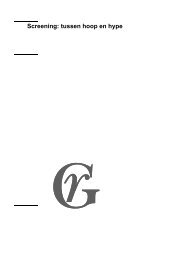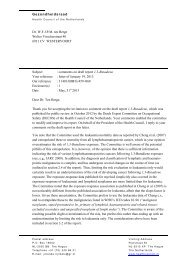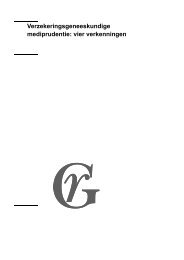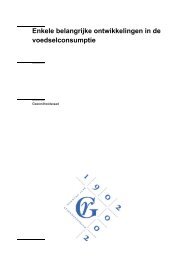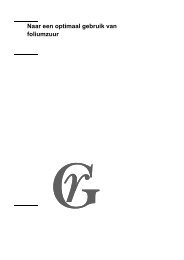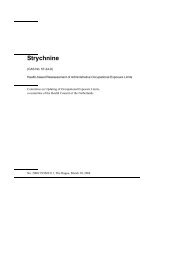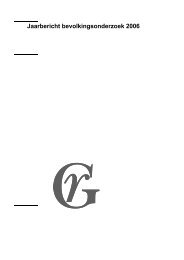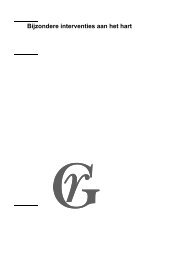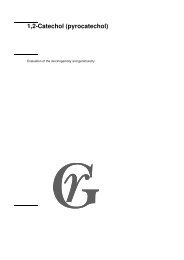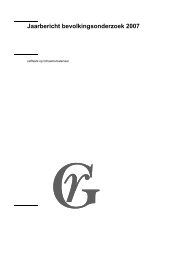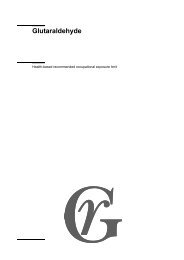Liquefied petroleum gas (LPG) - Gezondheidsraad
Liquefied petroleum gas (LPG) - Gezondheidsraad
Liquefied petroleum gas (LPG) - Gezondheidsraad
Create successful ePaper yourself
Turn your PDF publications into a flip-book with our unique Google optimized e-Paper software.
<strong>Liquefied</strong> <strong>petroleum</strong> <strong>gas</strong> (<strong>LPG</strong>)<br />
(CAS No: 68476-85-7)<br />
Propane<br />
(CAS No: 74-98-6)<br />
Butane<br />
(CAS No: 106-97-8)<br />
Health-based Reassessment of Administrative Occupational Exposure Limits<br />
Committee on Updating of Occupational Exposure Limits,<br />
a committee of the Health Council of the Netherlands<br />
No. 2000/15OSH/134 The Hague, November 9, 2004
Preferred citation:<br />
Health Council of the Netherlands: Committee on Updating of Occupational<br />
Exposure Limits. <strong>Liquefied</strong> <strong>petroleum</strong> <strong>gas</strong> (<strong>LPG</strong>), Propane, Butane; Healthbased<br />
Reassessment of Administrative Occupational Exposure Limits. The<br />
Hague: Health Council of the Netherlands, 2004; 2000/15OSH/134.<br />
all rights reserved
1 Introduction<br />
The present document contains the assessment of the health hazard of liquefied<br />
<strong>petroleum</strong> <strong>gas</strong> (<strong>LPG</strong>) and its components butane and propane by the Committee<br />
on Updating of Occupational Exposure Limits, a committee of the Health<br />
Council of the Netherlands. First drafts of separate documents on <strong>LPG</strong> and<br />
butane were prepared by MA Maclaine Pont, M.Sc. (Wageningen University and<br />
Research Centre, Wageningen, the Netherlands) and AAE Wibowo, Ph.D.<br />
(Coronel Institute, Academic Medical Centre, Amsterdam, the Netherlands),<br />
respectively.<br />
The evaluation of the toxicity of butane and propane has been based on the<br />
reviews by Berzins (Ber95a, Ber95b) and Low et al. (Low87a, Low87b). Where<br />
relevant, the original publications were reviewed and evaluated as will be<br />
indicated in the text. In addition, in February 1998, literature was searched on the<br />
databases Medline, Toxline, and Chemical Abstracts, starting from 1966, 1981,<br />
and 1937, respectively, and using the following key words: liquefied <strong>petroleum</strong><br />
<strong>gas</strong>, <strong>LPG</strong>, propane, butane, butylhydride, 68476-85-7, 74-98-6, and 106-97-8.<br />
Data on intoxication from combustion products were excluded from the<br />
document.<br />
In March 2000, the President of the Health Council released separate drafts<br />
of documents on butane and <strong>LPG</strong> for public review. Comments were received<br />
from the following individuals and organisations: A Aalto (Ministry of Social<br />
Affairs and Health, Tampere, Finland), JH Urbanus (CONCAWE, Brussels,<br />
Belgium), P Wardenbach, Ph.D. (Bundesanstalt für Arbeitsschutz and<br />
Arbeitsmedizin, Dortmund, FRG), and L Whitford (Health and Safety Executive,<br />
London, England). These comments were taken into account when deciding on<br />
the final version of the document*.<br />
An additional search in Toxline and Medline in April 2004 did not result in<br />
information changing the committee’s conclusions.<br />
* In the finalising phase, it was decided to combine the documents on <strong>LPG</strong> (including propane) and butane into one<br />
document.<br />
134-3 <strong>Liquefied</strong> <strong>petroleum</strong> <strong>gas</strong> (<strong>LPG</strong>), Propane, Butane
2 Identity<br />
name : liquefied <strong>petroleum</strong> <strong>gas</strong> propane butane<br />
synonyms : <strong>LPG</strong>; <strong>petroleum</strong> <strong>gas</strong>;<br />
bottled <strong>gas</strong><br />
n-propane; dimethylmethane;<br />
propyl hydride; propyl dihydride<br />
n-butane; butylhydride;<br />
methylethylmethane; diethyl<br />
molecular formula : C 3<br />
H 8<br />
C 4<br />
H 10<br />
structural formula : CH 3<br />
-CH 2<br />
-CH 3<br />
CH 3<br />
-CH 2<br />
-CH 2<br />
-CH 3<br />
CAS number : 68476-85-7 a<br />
74-98-6 106-97-8<br />
a<br />
CAS does not treat this substance as a unique chemical entity in its regular CA index processing.<br />
3 Physical and chemical properties<br />
<strong>LPG</strong> propane n-butane<br />
molecular weight 42-58 44.09 58.12<br />
boiling point >-44 o C -42.1 o C -0.5 o C<br />
melting point not available -189.7 o C -138.2 o C<br />
flash point not found -104 o C (closed cup) -60 o C (closed cup)<br />
vapour pressure >100 kPa at 21 o C: 853 kPa at 25 o C: 243 kPa<br />
solubility in water insoluble insoluble insoluble<br />
log P octanol/water<br />
not available 2.36 (experimental)<br />
1.81 (calculated)<br />
2.89 (experimental)<br />
2.31 (calculated)<br />
conversion factors<br />
at 20 o C, 101.3 kPa:<br />
1 mg/m 3 = 0.54 ppm<br />
1 ppm = 1.84 mg/m 3<br />
at 20 o C, 101.3 kPa:<br />
1 mg/m 3 = 0.41 ppm<br />
1 ppm = 2.42 mg/m 3<br />
Data from ACG02a, ACG02b, ACG02c, Ber95a, Ber95b, CON92, NLM04a, NLM04b, http://www.syrres.com/esc/<br />
est_kowdemo.htm.<br />
<strong>LPG</strong><br />
<strong>LPG</strong> is a by-product of <strong>petroleum</strong> refining. It is a colourless <strong>gas</strong> with a mild<br />
odour. An odour threshold ranging from 5000-20,000 ppm has been reported. A<br />
foul odorant (e.g., ethanethiol) is added commercially. <strong>LPG</strong> is highly flammable<br />
and is a dangerous fire and explosive hazard (ACG02a).<br />
<strong>LPG</strong> is commercially available as propane (often found in colder climates),<br />
butane (more widely found in the Southern States of the USA due to its higher<br />
freezing and boiling points), and butane-propane mixtures (ACG02a). Others<br />
state that <strong>LPG</strong> is predominantly a mixture of C 3<br />
and C 4<br />
hydrocarbons with other<br />
hydrocarbons in the C 1<br />
-C 7<br />
range. These are <strong>gas</strong>es at normal ambient<br />
temperatures and pressures (CON92). In the Netherlands, <strong>LPG</strong> is blended by the<br />
Shell Company mainly from propane/propene and butane/butene refinery<br />
streams, both streams consisting for >90% of C 3<br />
or C 4<br />
molecules, respectively.<br />
134-4 Health-based Reassessment of Administrative Occupational Exposure Limits
4 Uses<br />
The proportion of longer chain molecules (≥C 5<br />
) is 2% at most; the share of the<br />
unsaturated molecules is approximately 30%. The boiling point ranges from -40<br />
to +40 o C (Kat98).<br />
Propane<br />
Propane is a colourless and odourless flammable <strong>gas</strong> (Ber95a). Amoore and<br />
Hautala listed an odour threshold for propane of 16,000 ppm (29,440 mg/m 3 )<br />
(Amo83) while Ruth reported the odour threshold to range between 972 and<br />
19,440 ppm (1800 and 36,000 mg/m 3 ) (Rut86).<br />
Butane<br />
Butane is a colourless and flammable <strong>gas</strong> with a <strong>gas</strong>oline-like or natural <strong>gas</strong><br />
odour (ACG02c). Amoore and Hautala listed an odour threshold for butane of<br />
2700 ppm (6530 mg/m 3 ) (Amo83) while Ruth reported the odour threshold to<br />
range between 1.2 and 6 ppm (2.9 and 14.6 mg/m 3 ) (Rut86).<br />
<strong>LPG</strong><br />
<strong>LPG</strong>s are widely used as fuel and as feedstock in chemical processes. In some<br />
countries, there is also extensive use of <strong>LPG</strong> as automotive fuel. <strong>LPG</strong>s are also<br />
used as propellants in pressurised aerosol containers (CON92).<br />
Propane<br />
Propane is used as fuel <strong>gas</strong> in the household, industry, and vehicles (sometimes<br />
mixed with butane), in organic synthesis, as an intermediate in petrochemical<br />
manufacture, as a refrigerant and aerosol propellant (amongst others in<br />
cosmetics). It occurs in natural <strong>gas</strong> (Ber95a, Moo82). In the USA, it has a GRAS<br />
(‘generally recognised as safe’) status for use as a food additive, i.e., to expel a<br />
product or to reduce the amount of oxygen in contact with the food in the<br />
packaging (see Code of Federal Regulations: 21CFR184.1165; revised as of<br />
April 1, 2003).<br />
Butane<br />
Butane is used in liquid fuels of high octane, in organic synthesis of different<br />
chemicals, in the production of synthetic rubbers, as a refrigerant and aerosol<br />
propellant (amongst others in cosmetics), and as a constituent in liquid natural<br />
<strong>gas</strong> (Ber95b, Moo82). In the USA, it has a GRAS (‘generally recognised as<br />
safe’) status for use as a food additive, i.e., to expel a product or to reduce the<br />
134-5 <strong>Liquefied</strong> <strong>petroleum</strong> <strong>gas</strong> (<strong>LPG</strong>), Propane, Butane
amount of oxygen in contact with the food in the packaging (see Code of Federal<br />
Regulations: 21CFR184.1165; revised as of April 1, 2003).<br />
5 Biotransformation and kinetics<br />
<strong>LPG</strong><br />
In male ICR mice exposed to an unknown concentration of <strong>LPG</strong> (composition:<br />
97.4% propane, 0.3% butane, 1.2% ethane, and 1.1% 2-methylpropane) for 2<br />
hours, propane, butane, and 2-methylpropane and the metabolites 2-propanol,<br />
acetone, 2-butanol, and 2-butanone were identified in blood, brain, liver, and<br />
kidneys (Tsu85a).<br />
Propane<br />
One hour after inhalation of an unknown concentration of propane, unchanged<br />
compound was detected in blood, brain, liver, and kidneys of male ICR mice. 2-<br />
Propanol and acetone, metabolites of propane, were also identified. Following<br />
incubation of a saturated aqueous solution of propane (ca. 2.9 mM) with a mouse<br />
liver microsomal suspension in the presence of a NADPH-generating system,<br />
Tsukamoto et al. only found 2-propanol, while no ketone was detected. From<br />
these data, the authors presumed that propane was first metabolised into a<br />
secondary alcohol, 2-propanol, by the microsomal enzyme system and then into<br />
the corresponding ketone, acetone, by alcohol dehydrogenase (Tsu85a, Tsu85b).<br />
Propane has been detected in blood, brain, kidney, liver, and lungs of man<br />
following fatal propane exposure (Ber95a, Gra99).<br />
Butane<br />
In humans, absorption of butane was reported to be 30-45% of the dose inhaled<br />
(Fla90). Although the committee did not find data on absorption through the<br />
skin, dermal penetration of butane is expected to be low since skin contact is<br />
transient due to the volatility of the compound (Low87b).<br />
In a fatal case of butane abuse, levels of butane in liver, brain, blood, and<br />
kidneys amounted to 310, 282, 129, and 84 mg/kg or mg/L, respectively (Gra99).<br />
In rats exposed to a butane concentration of 100 ppm (240 mg/m 3 ) for 80<br />
minutes, the uptake was estimated to be 1.5-1.8 nmol/kg/min/ppm (0.09-0.1<br />
µg/kg/min/ppm) (Dah88). From this, a retention of ca. 10% can be calculated<br />
(assuming a rat body weight of 300 g and a minute volume of 125 mL/min).<br />
134-6 Health-based Reassessment of Administrative Occupational Exposure Limits
Butane is distributed to various tissues. After exposing rats to lethal<br />
concentrations of ca. 650,000 mg/m 3 (ca. 270,000 ppm) for 4 hours, Shugaev<br />
found the highest concentration of butane in the perirenal fat tissue, followed by<br />
the brain, spleen, liver, and kidney (Shu69).<br />
One hour after inhalation to an unknown concentration of butane, unchanged<br />
compound was detected in blood, brain, liver, and kidneys of male ICR mice.<br />
2-Butanol and 2-butanone, metabolites of butane, were also identified. As with<br />
propane (see above), incubation of a saturated aqueous solution of butane (ca. 6.7<br />
mM) with a mouse liver microsomal suspension in the presence of a NADPHgenerating<br />
system, only 2-butanol, but no ketone was detected. Tsukamoto<br />
proposed a metabolism scheme similar to that described above for propane<br />
(Tsu85a, Tsu85b).<br />
Low et al. reported that in rat liver microsomes, butane was hydroxylated<br />
yielding 2-butanol as the major metabolite. Butane was the lowest molecular<br />
weight alkane demonstrated to bind as a substrate to cytochrome P450. The<br />
authors suggested that if 2-butanol would be the major metabolite formed in<br />
mammals, it could be excreted in exhaled air. Like other alcoholic metabolites<br />
formed from hydroxylation of normal alkanes, 2-butanol may also be conjugated<br />
with glucuronic acid or be oxidised into methyl ethyl ketone, which could be<br />
expired as well (Low87b).<br />
Because of its volatile nature, unchanged butane may also be exhaled, and its<br />
determination in exhaled air might be used for biological monitoring purposes.<br />
6 Effects and mechanism of action<br />
Human data<br />
<strong>LPG</strong><br />
A few cases on death following accidental or intentional inhalation of <strong>LPG</strong> have<br />
been reported (Kir92, Fuk96). Aydin and Özçakar described a case of a 28-yearold<br />
man complaining of nausea, malaise, and generalised weakness of the lower<br />
limbs. The patient was hospitalised with a diagnosis of suspected acute hepatitis<br />
that was attributed to have been working in an enclosed space fixing <strong>gas</strong><br />
cylinders containing a propane-butane mixture (Ayd03). Abnormal liver function<br />
and neurological symptoms were found in a 63-year-old man after inhaling a<br />
mixture containing propane, butane, and 2-methylpropane (30-35%), but also<br />
<strong>petroleum</strong> distillates 25-35%), pentane (10-15%), and acetone (1-5%). The<br />
symptoms subsided after discontinuation of exposure (Pya98).<br />
134-7 <strong>Liquefied</strong> <strong>petroleum</strong> <strong>gas</strong> (<strong>LPG</strong>), Propane, Butane
Propane<br />
At very high levels, propane has CNS depressant and asphyxiating properties.<br />
Several cases of fatal inhalation of propane have been described (Avi94, Gra99,<br />
Sie90, Tso98; see also Ber95a, Cav94). Bowen et al. reported that out of 52<br />
deaths associated with accidental or intentional inhalation of volatile compounds<br />
in Virginia (USA) in the period 1987-1996, 6 cases were due to suicide and 7 to<br />
accidental overexposure in, usually, the workplace, but the compounds involved<br />
were not specified. Of the remaining 39 cases in which death was considered to<br />
be a direct consequence of inhalant abuse, 5 were associated with propane<br />
(Bow99).<br />
A 17-year-old male reported feelings of euphoria, ataxia, and lightheadedness<br />
without loss of consciousness when inhaling propane intentionally<br />
for 10-15 seconds and subsequently holding his breath for up to one minute.<br />
These sensations lasted for 1-2 minutes. This inhalation pattern would be<br />
repeated daily for periods up to 3 hours for 6 months. The man complained of<br />
severe headache and memory loss on the morning after exposure. Physical<br />
examination, including a neurological assessment, and laboratory tests (complete<br />
blood count with differential, blood urea nitrogen, serum creatinine, electrolytes,<br />
routine urinalysis, liver function tests) did not reveal abnormalities (Whe92).<br />
Several cases of cold injury from liquid propane have been published. The<br />
injuries were similar to frostbite but the symptoms occurred more rapidly with<br />
propane (Ber95a).<br />
No changes in EEGs, adrenocortical functions, pulmonary functions,<br />
neurological response, subjective response, cardiac function, cognitive response,<br />
or visual evoked response were seen in 8 men and women exposed to propane<br />
concentrations of 250 and 1000 ppm (460 and 1840 mg/m 3 ) for 1 minute to 8<br />
hours or in 2 men and 2 women exposed to 1000 ppm (1840 mg/m 3 ) propane, 8<br />
hours/day for 5 consecutive days at one week and 4 consecutive days the<br />
following week (Ber95a, Low87a, Moo82).<br />
Ten-minute exposures to 10,000 ppm (18,400 mg/m 3 ) did not produce<br />
symptoms in 6 men and women; distinct vertigo, but no mucosal irritation of<br />
nose, eyes, or respiratory tract, was observed at exposures to up to 100,000 ppm<br />
(184,000 mg/m 3 ) for 2 minutes (Moo82).<br />
Assuming a correlation between the anaesthetic potency of a <strong>gas</strong> and its air/<br />
olive oil partition coefficient, Drummond expected that a concentration of<br />
propane of 47,000 ppm (86,500 mg/m 3 ) would induce narcosis in man (Dru93).<br />
134-8 Health-based Reassessment of Administrative Occupational Exposure Limits
Butane<br />
Several individual cases or retrospective studies (in e.g., England, Germany, and<br />
the USA) in which butane was identified as the toxic agent have been reported.<br />
They mostly concern its abuse as an inhalant, from, e.g., lighters or hair/<br />
deodorant sprays, by teenagers and adolescents. Butane abuse was fatal, mostly<br />
due to heart failure (arrhythmias, ventricular fibrillation, asystole) (Bla98,<br />
Bow99, Cha02, Dör02, Fie03, Gra99, Rob90, Roh97, Weh02, Wil98) and, in one<br />
case, due to multiple organ failure involving the central nervous system,<br />
cardiovascular system, pulmonary system, and the liver (Rie00). Bowen et al.<br />
reported that out of 52 deaths associated with accidental or intentional inhalation<br />
of volatile compounds in Virginia (USA) in the period 1987-1996, 6 cases were<br />
due to suicide and 7 to accidental overexposure in, usually, the workplace, but<br />
the compounds involved were not specified. Of the remaining 39 cases in which<br />
death was considered to be a direct consequence of inhalant abuse, 13 were<br />
associated with butane (Bow99). Butane induced severe acute neurological<br />
(seizure, somnolence, coma) or cardiovascular (ventricular fibrillation, asystole,<br />
collapse) complications and minor symptoms such as nausea, dizziness,<br />
vomiting, headache, and sore throat (Dör02, Edw00, ONe99). Döring et al.<br />
described a case of severe encephalopathy in a 15-year-old girl having inhaled<br />
butane repeatedly for 4 weeks when an acute abuse incident occurred. After<br />
admittance to the hospital, involving cardiopulmonary resuscitation, 6-day<br />
catecholamine treatment, and 11-day mechanic ventilation, severe brain damage<br />
with vigil coma and spastic quadriplegia became obvious during the following<br />
weeks. Repetitive MRI-imaging revealed disintegration of grey matter,<br />
increasing cerebral atrophy, and destruction of basal ganglia while EEG showed<br />
strongly diminished basal activity with flat amplitude (Dör02). Gray and Lazarus<br />
presented a case of a right-sided hemiparesis characterised by markedly reduced<br />
power - grade 1/5 - in the right arm and leg, flaccid tone, and absent reflexes with<br />
an extensor plantar reflex on this side (Gra93). Frangides et al. reported a (very<br />
rare) case of non-fatal acute massive rhabdomyolysis in a 27-year-old man due to<br />
accidental inhalation of liquid <strong>gas</strong> fumes leaking from a tank containing a<br />
mixture of butane (80%), propane (20%), ethanethiol, and olefines (Fra03).<br />
McIntyre and Long concluded that fulminant hepatic failure after taking a<br />
proprietary engine or carburettor cleaner, containing isopropyl alcohol, mineral<br />
oil, and aromatic <strong>petroleum</strong> products, was the cause of death of a 17-year-old<br />
male having been abusing butane aerosols for 3 years (McI92).<br />
Two cases of pregnant women accidentally (in pregnancy week 27) or<br />
intentionally (suicide attempt in week 30) were reported. The first woman gave<br />
birth to a child with hydranencephaly (Fer86), while the second woman gave<br />
134-9 <strong>Liquefied</strong> <strong>petroleum</strong> <strong>gas</strong> (<strong>LPG</strong>), Propane, Butane
irth to a child that died after 11 hours with severe encephalomalacia and<br />
hypoplastic kidneys (Gos82). In both cases, these brain effects were not<br />
considered to be a butane-specific effect but to have been caused by intrauterine<br />
anoxia. In neither of these cases, estimations of the concentrations inhaled were<br />
made.<br />
Viau et al. did not find clinically significant effects on sensitive biochemical<br />
and immunological markers of kidney (functioning) in 53 male refinery workers<br />
who were occupationally exposed for an average of 11 years to a number of<br />
hydrocarbons, among which butane (concentration ranged from 0.4 to 17.8<br />
mg/m 3 ) (Via87).<br />
In human subjects exposed to a butane concentration of 10,000 ppm (24,200<br />
mg/m 3 ) for 10 minutes, drowsiness was reported (no more data presented)<br />
(Low87b, Moo82).<br />
Assuming a correlation between the anaesthetic potency of a <strong>gas</strong> and its air/<br />
olive oil partition coefficient, Drummond expected that a concentration of butane<br />
of 17,000 ppm (40,290 mg/m 3 ) would induce narcosis in man (Dru93).<br />
Animal data<br />
<strong>LPG</strong><br />
The committee did not find data from experimental animal studies with <strong>LPG</strong>.<br />
Propane<br />
The committee did not find data on the irritating properties of propane or of<br />
formulations containing propane only. Applications of several formulations<br />
containing 63-69% 2-methylpropane and 12-13% propane to the clipped back<br />
skin of rabbits resulted in primary irritation index scores of 0.38-0.73 (maximum<br />
possible score: 8.0) (Moo82).<br />
In guinea pigs, irregular breathing or tremors (during the first 5 minutes)<br />
were observed at 5-120 minute exposures to ca. 44,000-53,000 (24,000-29,000<br />
ppm) or 86,000-101,000 mg/m 3 (47,000-55,000 ppm), respectively. Nausea,<br />
retching, and stupefaction were seen at longer exposure durations; narcotic<br />
effects not until exposure levels were ca. 92,000 mg/m 3 (50,000 ppm). No<br />
mortality or pathological changes were observed (Low87a). The EC 50<br />
for effects<br />
on the central nervous system (ataxia and loss of righting reflex) in rats was ca.<br />
52,000 mg/m 3 (28,000 ppm) (exposure time: 10 minutes) (Cla82). When propane<br />
was administered by tracheal cannula to anaesthetised rhesus monkeys (n=3/<br />
group) at concentrations of ca. 180,000 and 360,000 mg/m 3 (100,000 or 200,000<br />
ppm), for 5 minutes followed by inhalation of room air for 10 minutes, it induced<br />
134-10 Health-based Reassessment of Administrative Occupational Exposure Limits
increases (not statistically significant: p>0.05) in bronchoconstriction and<br />
respiratory depression at the high level, but no arrhythmia or myocardial<br />
depression (Bel74, Avi75). In anaesthetised mice and unanaesthetised dogs,<br />
propane did not induce arrhythmias either but (weakly) sensitised the heart to<br />
epinephrine-induced cardiac arrhythmias at concentrations of ca. 180,000 and<br />
360,000 mg/m 3 (100,000 and 200,000 ppm), but in dogs not at ca. 90,000 mg/m 3<br />
or 50,000 ppm (exposure time: mice: 6 minutes; dogs: 10 minutes) (Avi74,<br />
Rei71). Similar effects were observed in dogs exposed to concentrations of ca.<br />
280,000 to 1,656,000 mg/m 3 (150,000-900,000 ppm) for 10 minutes (Low87a).<br />
In another study, propane was a weak cardiac sensitiser in dogs: the EC 50<br />
was ca.<br />
33,000 mg/m 3 (18,000 ppm) (exposure time: 5 minutes) (Cla82).<br />
The committee did not find data from repeated-dose toxicity studies<br />
(including carcinogenicity and reproduction toxicity) on propane alone.<br />
Propane (purity: >99.9%) did not induce mutations when tested with and without<br />
an induced rat liver metabolic activation system in S. typhimurium strains<br />
TA1535, TA1537, TA1538, TA98, and TA100 at concentrations of 5-50% (v/v)<br />
in a desiccator (exposure time: 6 hours) (Kir80).<br />
Butane<br />
Injection of liquid butane into the anterior eye chamber of rabbits did not cause<br />
disturbance, and all effects disappeared in 2-4 days (Gra74).<br />
Kane and Alarie exposed groups of male Swiss-Webster mice to<br />
photochemical oxidant mixtures generated by a reaction between various<br />
hydrocarbons, among which butane, and nitrogen dioxide in the presence of<br />
ultraviolet light. Meanwhile, the respiratory rates of the mice were monitored.<br />
The initial hydrocarbon concentrations ranged from 0.4 to 18 ppm (0.9-42.7<br />
mg/m 3 ) with the initial nitrogen dioxide concentration being one-third of the<br />
initial hydrocarbon concentration. Concomitant exposure to butane and nitrogen<br />
dioxide did not significantly affect respiratory rate, indicating no irritation of the<br />
upper respiratory tract. The authors also reported that butane did not cause<br />
irritation to the eyes of the mice (Kan78). In guinea pigs, exposure to<br />
concentrations of butane of 21,000-56,000 ppm (ca. 50,800-135,000 mg/m 3 )<br />
caused increased respiratory rate, sniffing, and chewing movements, animals<br />
recovering quickly after cessation of exposure (Low87b).<br />
Acute LC 50<br />
values were 658,000 and 680,000 mg/m 3 (ca. 270,000 and<br />
279,000 ppm) in rats (exposure duration: 4 hours) and mice (2 hours),<br />
respectively (Shu69). In mice, 40 and 60% of the animals died at 2-hour<br />
exposures to ca. 653,000 and 750,000 mg/m 3 (270,000 and 310,000 ppm),<br />
134-11 <strong>Liquefied</strong> <strong>petroleum</strong> <strong>gas</strong> (<strong>LPG</strong>), Propane, Butane
espectively. Slight anaesthesia was observed at exposure to 130,000 or 220,000<br />
ppm (314,600 and 532,400 mg/m 3 ) for 25 and 1 minute, respectively, while 15-<br />
minute exposure to the higher concentration induced complete anaesthesia<br />
(Ber95b, Low87b). In dogs, concentrations of 200,000-250,000 ppm (484,000-<br />
605,000 mg/m 3 ) caused anaesthesia and mortality within a few minutes. Other<br />
studies showed butane to sensitise the heart to epinephrine-induced cardiac<br />
arrhythmias or ventricular fibrillation at levels of 150,000-900,000 (363,000-<br />
2,178,000 mg/m 3 ), for 10 minutes, and of 10,000-200,000 ppm (24,200-484,000<br />
mg/m 3 ), for 2 minutes to 2 hours, respectively (Ber95b, Low87b), while<br />
exposure to 5000 ppm (12,100 mg/m 3 ) had caused haemodynamic changes in<br />
anaesthetised dogs, such as a decrease in cardiac output, left ventricular pressure,<br />
and stroke volume, a decrease in myocardial contractility, and aortic pressure<br />
(Low87b).<br />
Halder et al. examined the toxicity of a hydrocarbon blend vapour consisting<br />
of 25% (w/w) each of butane, pentane, isobutane, and isopentane by exposing<br />
rats (Sprague-Dawley; n=10/sex/group) to, analytical, time-weighted average,<br />
total hydrocarbon concentrations of 0, 116, 1150, or 11,800 mg/m 3<br />
(0, 44, 432, and 4437 ppm). Particular attention was paid to effects on the<br />
kidneys. Histological examinations were also done on the brain, heart, liver,<br />
spleen, adrenals, and gonads. During exposure, no clinical signs of toxicity were<br />
observed. Post-mortem examinations did not show macroscopic or microscopic<br />
changes in any of the organs examined in any of the treated groups and no<br />
evidence of the presence of the male-rat-specific, hydrocarbon-induced<br />
nephropathy (Hal86). From this study, the committee concluded that the NOAEL<br />
for rats is at least 11,800 mg/m 3 for total hydrocarbons and at least 2950 mg/m 3<br />
(1210 ppm) for butane.<br />
The same research group exposed 20 male and 10 female rats (Fischer 344)<br />
to analytical, time-weighted average, concentrations of a mixture of butane and<br />
pentane of 1017 and 4489 ppm, for 13 weeks. The relative proportions of butane<br />
in the mixture were 51.5 and 47.5 wt%, respectively. A control group consisting<br />
of 40 male and 20 female animals was included. At day 28, necropsies were<br />
performed for half of the male rats of each treatment group. All animals survived<br />
exposure. Aranyi et al. reported possible treatment-related, but not dose-related,<br />
signs of toxicity including transient hunched posture and/or lethargy and<br />
intermittent tremor and statistically significantly decreased body weights for<br />
both males and females by test week 3 and 4. At the end of the study, body<br />
weights were comparable to those of controls. At post-mortem examinations,<br />
liver and kidney weights were not affected and no gross, treatment-related<br />
lesions were observed. Only the kidneys were examined microscopically and<br />
134-12 Health-based Reassessment of Administrative Occupational Exposure Limits
scored based on the presence of hyaline droplet accumulation in the proximal<br />
tubule epithelial cells, of foci of regenerative tubular epithelium in the cortical<br />
region of the kidney, and of dilated tubuli filled with granular material located at<br />
the junction between the inner and outer stripes of the medulla. These kidney<br />
lesions were seen in all male treated and control groups but not in the female<br />
groups. Compared with controls, there were dose-related, not statistically<br />
significant increases in scores at the 28-day interim kill, but scores did not differ<br />
between male groups at study termination (Ara86). From this study, the<br />
committee concluded that the NOAEL for rats is at least 4489 ppm for the<br />
butane/pentane mixture and at least 2343 ppm (5670 mg/m 3 ; calculated based on<br />
relative proportion of butane in this mixture of 47.5 wt%) for butane.<br />
The committee did not find data from repeated-dose toxicity studies<br />
(including carcinogenicity and reproduction toxicity) on butane alone.<br />
Tested under similar conditions as propane (see above), butane (purity: 99.7%)<br />
was negative in S. typhimurium strains TA1535, TA1537, TA1538, TA98, and<br />
TA100 (Kir80). Shimizu et al. obtained negative results as well when butane<br />
(purity: 99%) was tested with and without metabolic activation in these 5<br />
Salmonella strains as well as in E. coli strain WP2 uvrA at concentrations of 250-<br />
10,000 ppm (Shi85).<br />
Butane was negative in the sex-linked recessive lethal mutation assay in D.<br />
melano<strong>gas</strong>ter, exposed by inhalation to 350,000 ppm n-butane (Fou94).<br />
7 Existing guidelines<br />
The current administrative occupational exposure limits (MAC) for <strong>LPG</strong> and<br />
butane in the Netherlands are 1800 and 1430 mg/m 3 (1000 and 600 ppm), 8-hour<br />
TWA, respectively. For propane, no administrative MAC value has been<br />
established. Propane is considered to act as a simple asphyxiant, when present at<br />
high concentrations in air, by reducing the oxygen content air by dilution to such<br />
an extent that life cannot be supported. In order to prevent this, the content of<br />
oxygen in air should be at least 18% (v/v).<br />
Existing occupational exposure limits for <strong>LPG</strong>, propane, and butane in some<br />
European countries and in the USA are summarised in the annex.<br />
134-13 <strong>Liquefied</strong> <strong>petroleum</strong> <strong>gas</strong> (<strong>LPG</strong>), Propane, Butane
8 Assessment of health hazard<br />
Propane<br />
Data from studies using mouse liver microsomal suspensions and mice suggest<br />
that propane might be metabolised into 2-propanol and acetone through<br />
oxidation by the microsomal enzyme system and alcohol dehydrogenase,<br />
respectively. Propane has been detected in blood, brain, liver, and kidneys of<br />
mice and men and in the lungs of men.<br />
Human data include several cases of fatal (intentional) inhalation of propane.<br />
In one case of long-term propane abuse, euphoria, ataxia, light-headedness,<br />
severe headache, and memory loss were reported, but no abnormalities were<br />
found at physical examination (including a neurological assessment, and<br />
laboratory - blood, liver function – tests). No changes in EEGs, adrenocortical<br />
functions, pulmonary functions, neurological response, subjective response,<br />
cardiac function, cognitive response, or visual evoked response were seen in<br />
volunteers exposed to 1000 ppm (1840 mg/m 3 ) propane, 8 hours/day, for 9 days.<br />
Ten-minute exposures to 10,000 ppm (18,400 mg/m 3 ) did not produce<br />
symptoms, but 2-minute exposures up to 100,000 ppm (184,000 mg/m 3 ) resulted<br />
in distinct vertigo, but no mucosal irritation of nose, eyes, or respiratory tract.<br />
Dermal contact with liquid propane can cause frostbite.<br />
In guinea pigs exposed to ca. 44,000-53,000 (24,000-29,000 ppm) or 86,000-<br />
101,000 mg/m 3 (47,000-55,000 ppm) for 5-120 minutes, irregular breathing,<br />
nausea, retching, stupefaction, tremors (at 86,000-101,000 mg/m 3 ), and narcosis<br />
(at levels of ca. 92,000 mg/m 3 or 50,000 ppm), but no mortality or pathological<br />
changes were observed. Five-minute exposure by tracheal cannula to<br />
concentrations of 360,000 mg/m 3 (200,000 ppm) did not induce<br />
bronchoconstriction, respiratory depression, arrhythmia, or myocardial<br />
depression in rhesus monkeys. In mice and dogs, 6-10 minute exposure to<br />
180,000 mg/m 3 (100,000 ppm) did not induced arrhythmia but (weakly)<br />
sensitised the heart to epinephrine-induced cardiac arrhythmias.<br />
The committee did not find data from experiments on the toxicity (including<br />
carcinogenicity and reproduction toxicity) of propane following repeated<br />
exposure.<br />
Apart from a negative result in an in vitro mutation assay in S. typhimurium,<br />
the committee did not find data from mutagenicity and genotoxicity studies on<br />
propane.<br />
134-14 Health-based Reassessment of Administrative Occupational Exposure Limits
The committee considers the toxicological database on propane too poor to<br />
justify recommendation of a health-based occupational exposure limit.<br />
Butane<br />
In humans, absorption of butane was stated to be 30-45% of the dose inhaled.<br />
From experiments in which rats were exposed to butane concentrations of 100<br />
ppm (240 mg/m 3 ) for 80 minutes, the committee calculated absorption to be ca.<br />
10%. Although the committee did not find data on absorption through the skin,<br />
dermal penetration of butane is expected to be low since skin contact is transient<br />
due to the volatility of the compound. Following exposure of rats to lethal<br />
concentrations of ca. 650,000 mg/m 3 (ca. 270,000 ppm), for 4 hours, the highest<br />
concentrations of butane were found in the perirenal fat tissue, followed by the<br />
brain, spleen, liver, and kidney. In vivo and in vitro experiments suggest that<br />
butane might be metabolised into 2-butanol by the microsomal enzyme system<br />
followed by conjugation with glucuronic acid or oxidation into 2-butanone by<br />
alcohol dehydrogenase.<br />
Human data on effects of exposure to butane mostly concern its abuse as an<br />
inhalant, from, e.g., lighters or hair/deodorant sprays. Butane abuse was<br />
frequently fatal, mostly due to heart failure (arrhythmias, ventricular fibrillation,<br />
asystole). In non-fatal cases, butane induced severe acute neurological (seizure,<br />
somnolence, coma) or cardiovascular (ventricular fibrillation, asystole, collapse)<br />
complications and minor symptoms such as nausea, dizziness, vomiting,<br />
headache, and sore throat. However, no quantitative exposure data were<br />
available.<br />
Butane was not irritating to the eyes of rabbits when injected as a liquid into<br />
the anterior chamber or to the upper respiratory tract of mice. In guinea pigs,<br />
some transient irritation (increased respiratory rate, sniffing, and chewing<br />
movements) during exposure to concentrations of 21,000-56,000 ppm (ca.<br />
50,800-135,000 mg/m 3 ) was observed. Acute LC 50<br />
values were 658,000 and<br />
680,000 mg/m 3 (269,780 and 278,800 ppm) in rats (exposure duration: 4 hours)<br />
and mice (2 hours), respectively. In mice, 25-minute to 130,000 ppm (314,600<br />
mg/m 3 ) or 1-minute exposure to 220,000 ppm (532,400 mg/m 3 ) induced slight<br />
anaesthesia; 15-minute exposure to 222,000 ppm complete anaesthesia. In dogs,<br />
concentrations of 200,000-250,000 ppm (484,000-605,000 mg/m 3 ) caused<br />
anaesthesia and mortality within a few minutes. Butane had a cardiac sensitising<br />
effect in dogs.<br />
The committee did not find data from experiments on the toxicity (including<br />
carcinogenicity and reproduction toxicity) of butane following repeated<br />
exposure.<br />
134-15 <strong>Liquefied</strong> <strong>petroleum</strong> <strong>gas</strong> (<strong>LPG</strong>), Propane, Butane
Data on rats exposed to mixtures of aliphatic hydrocarbons showed that<br />
exposure to a mixture containing an estimated concentration of butane of 2950<br />
mg/m 3 did not induce an increase in the incidence of macroscopic or microscopic<br />
organ lesions. Exposure to another mixture containing an estimated<br />
concentration of butane of 5670 mg/m 3 increased the incidence of kidney lesions<br />
(hydrocarbon-induced nephropathy) when compared to controls. However, in<br />
these studies, effect levels were not identified and effects on the central nervous<br />
system, a potential target organ, were not addressed. Therefore, the committee is<br />
of the opinion that the studies cannot be used as starting points in deriving a<br />
health-based occupational exposure limit.<br />
Butane was negative in in vitro mutation assays in S. typhimurium and E. coli<br />
and in a sex-linked recessive lethal mutation assay in D. melano<strong>gas</strong>ter.<br />
The committee considers the toxicological database on butane too poor to justify<br />
recommendation of a health-based occupational exposure limit.<br />
Based on the animal data from studies with butane-containing mixtures (Ara86,<br />
Hal86), the committee concludes that there is no reason to suspect that the<br />
current occupational exposure limit of 1430 mg/m 3 (600 ppm), as an 8-hour<br />
time-weighted average, is too high.<br />
<strong>LPG</strong><br />
Apart from a few fatal cases and one case of nausea, malaise, general weakness<br />
of the lower limbs, and acute hepatitis, the committee did not find any<br />
information from reports on toxic effects of <strong>LPG</strong> in men and experimental<br />
animals.<br />
The committee considers the toxicological database on <strong>LPG</strong> too poor to justify<br />
recommendation of a health-based occupational exposure limit.<br />
Based on the available human and animal data on butane, the committee has no<br />
reason to suspect that the current administrative MAC value for <strong>LPG</strong> of 1800<br />
mg/m 3 (1000 ppm), as an 8-hour time-weighted average, is too high.<br />
References<br />
ACG02a<br />
American Conference of Governmental Industrial Hygienists (ACGIH). Liquified <strong>petroleum</strong> <strong>gas</strong>. In:<br />
Documentation of the TLVs ® and BEIs ® with other worldwide occupational exposure values. CD-<br />
ROM - 2002. Cincinnati, OH, USA: ACGIH ® , 2002.<br />
134-16 Health-based Reassessment of Administrative Occupational Exposure Limits
ACG02b American Conference of Governmental Industrial Hygienists (ACGIH). Propane. In: Documentation<br />
of the TLVs ® and BEIs ® with other worldwide occupational exposure values. CD-ROM - 2002.<br />
Cincinnati, OH, USA: ACGIH ® , 2002.<br />
ACG02c American Conference of Governmental Industrial Hygienists (ACGIH). Butane, all isomers: In:<br />
Documentation of the TLVs ® and BEIs ® with other worldwide occupational exposure values. CD-<br />
ROM - 2002. Cincinnati OH, USA: ACGIH ® , 2002.<br />
ACG04a American Conference of Governmental Industrial Hygienists (ACGIH). Guide to occupational<br />
exposure values - 2004. Cincinnati OH, USA: ACGIH ® , 2004: 17, 84, 120.<br />
ACG04b American Conference of Governmental Industrial Hygienists (ACGIH). 2004 TLVs ® and BEIs ®<br />
based on the documentation of the Threshold Limit Values for chemical substances and physical<br />
agents & Biological Exposure Indices. Cincinnati OH, USA: ACGIH ® , 2004: 15, 36, 47.<br />
Amo83 Amoore JE, Hautala E. Odor as an aid to chemical safety: odor thresholds compared with threshold<br />
limit values and volatilities for 214 industrial chemicals in air and water dilution. J Appl Toxicol<br />
1983; 3: 272-90.<br />
Ara86 Aranyi C, O'Shea WJ, Halder CA, et al. Absence of hydrocarbon-induced nephropathy in rats<br />
exposed subchronically to volatile hydrocarbon mixtures pertinent to <strong>gas</strong>oline. Toxicol Ind Health<br />
1986; 2: 85-98.<br />
Arb02 Arbejdstilsynet. Grænseværdier for stoffer og materialer. Copenhagen, Denmark: Arbejdstilsynet,<br />
2002: 18, 26, 35 (At-vejledning C.0.1).<br />
Avi74 Aviado DM, Belej MA. Toxicity of aerosol propellants in the respiratory and circulatory systems. I.<br />
Cardiac arrhythmia in the mouse. Toxicology 1974; 2: 31-42.<br />
Avi75 Aviado DM, Smith DG. Toxicity of aerosol propellants in the respiratory and circulatory systems.<br />
VIII. Respiration and circulation in primates. Toxicology 1975; 3: 241-52.<br />
Avi94 Avis PS, Archibald JT. Asphyxial suicide by propane inhalation and plastic bag suffocation. J Forens<br />
Sci 1994; 39: 253-6.<br />
Ayd03 Aydin Y, Özçakar L. Occupational hepatitis due to chronic inhalation of propane and butane <strong>gas</strong>es.<br />
Int J Clin Pract 2003; 57: 546.<br />
Bel74 Belej MA, Smith DG, Aviado DM. Toxicity of aerosol propellants in the respiratory and circulatory<br />
systems. IV. Cardiotoxicity in the monkey. Toxicology 1974; 2: 381-95.<br />
Ber95a Berzins T. n-Propane. Nordia 1995; 28: 175-92.<br />
Ber95b Berzins T. Butane. Nordia 1995; 28: 10-26.<br />
Bla98 Bland JM, Taylor J. Deaths from accidental drug poisoning in teenagers. Deaths due to volatile<br />
substance misuse are greatly underestimated. BMJ 1998; 316: 146.<br />
Bow99 Bowen SE, Daniel J, Balster RL. Deaths associated with inhalant abuse in Virginia from 1987 to<br />
1996. Drug Alcohol Depend 1999; 53: 239-45.<br />
Cav94 Cavender F. Toxicology of aliphatic hydrocarbons. In: Clayton GD, Clayton FE, ed. Toxicology. 4th<br />
ed. New York, USA: J Wiley and Sons, 1994: 1221-66 (Patty's industrial hygiene and toxicology; Vol<br />
IIB).<br />
Cha02 Chaudhry S. Deaths from volatile substance misuse fall. BMJ 2002; 325: 122.<br />
134-17 <strong>Liquefied</strong> <strong>petroleum</strong> <strong>gas</strong> (<strong>LPG</strong>), Propane, Butane
Cla82 Clark DG, Tinston DJ. Acute inhalation toxicity of some halogenated and non-halogenated<br />
hydrocarbons. Hum Toxicol 1982; 1: 239-47.<br />
CON92 CONCAWE. <strong>Liquefied</strong> <strong>petroleum</strong> <strong>gas</strong>. Brussels, Belgium: CONCAWE, 1992; Product dossier no.<br />
92/102.<br />
Dah88 Dahl AR, Damon EG, Mauderly JL, et al. Uptake of 19 hydrocarbon vapors inhaled by F344 rats.<br />
Fundam Appl Toxicol 1988; 10: 262-9.<br />
DFG04 Deutsche Forschungsgemeinschaft (DFG): Commission for the Investigation of Health Hazards of<br />
Chemical Compounds in the Work Area. List of MAK and BAT values 2004. Maximum<br />
concentrations and Biological Tolerance Values at the workplace Weinheim, FRG: Wiley-VCH<br />
Verlag GmbH & Co. KGaA, 2004: 31, 99 (rep no 40).<br />
Dör02 Döring G, Baumeister FAM, Peters J, et al. Butane abuse associated encephalopathy. Klin Pädiatr<br />
2002; 214: 295-8.<br />
Dru93 Drummond I. Light hydrocarbon <strong>gas</strong>es: a narcotic, asphyxiant, or flammable hazard? Appl Occup<br />
Environ Hyg 1993; 8: 120-5.<br />
EC04 European Commission: Directorate General of Employment and Social Affairs. Occupational<br />
exposure limits (OELs). http://europe.eu.int/comm/employment_social/health_safety/areas/<br />
oels_en.htm.<br />
Edw00 Edwards KE, Wenstone R. Successful resuscitation from recurrent ventricular fibrillation secondary<br />
to butane inhalation. Br J Anaesth 2000; 84: 803-5.<br />
Fer86 Fernàndez F, Pèrez-Higueras A, Hernàndez R, et al. Hydranencephaly after maternal butane-<strong>gas</strong><br />
intoxication during pregnancy. Dev Med Child Neurol 1986: 28: 361-3.<br />
Fie03 Field-Smith ME, Butland BK, Ramsey JD, et al. Trends in death associated with abuse of volatile<br />
substances. London, UK: St George’s Hospital Medical School, Department of Community Health<br />
Sciences, 2003; http://www.vsareport.org.<br />
Fla90 Flanagan RJ, Ruprah M, Meredith TJ, et al. An introduction to the clinical toxicology of volatile<br />
substances. Drug Saf 1990; 5: 359-83.<br />
Fou94 Foureman P, Mason JM, Valencia R, et al. Chemical mutagenesis testing in Drosophila. X. Results of<br />
70 coded chemicals tested for the National Toxicology Program. Environ Mol Mutagen 1994; 23:<br />
208-27.<br />
Fra03 Frangides CY, Tzortzatos GV, Koulouras V, et al. Acute massive rhabdomyolysis due to prolonged<br />
inhalation of liquid <strong>gas</strong>. Eur J Emerg Med 2003; 10: 44-6.<br />
Fuk96 Fukunaga T, Yamamoto H, Tane<strong>gas</strong>hima A, et al. <strong>Liquefied</strong> <strong>petroleum</strong> <strong>gas</strong> (<strong>LPG</strong>) poisoning: report of<br />
two cases and review of the literature. Forensic Sci Int 1996; 82: 193-200.<br />
Gos82 Gosseye S, Golaire MC, Larroche JC. Cerebral, renal and splenic lesions due to fetal anoxia and their<br />
relationships to malformations. Dev Med Child Neurol 1982; 24: 510-8.<br />
Gra74 Grant WM. Toxicology of the eye. 2nd ed. Springfield IL, USA: Charles C Thomas, 1974.<br />
Gra93 Gray MY, Lazarus JH. Butane inhalation and hemiparesis. Clin Toxicol 1993; 31: 483-5.<br />
Gra99 Graefe A, Müller RK, Vock R, et al. Tödliche Intoxikationen durch Propan-Butan. Arch Kriminol<br />
1999; 203: 27-31.<br />
134-18 Health-based Reassessment of Administrative Occupational Exposure Limits
Hal86 Halder CA, van Gorp GS, Hatoum NS, et al. Gasoline vapor exposures, Part II. Evaluation of the<br />
nephrotoxicity of the major C4/C5 hydrocarbon components. Am Ind Hyg Ass J 1986; 47: 173-5.<br />
HSE02 Health and Safety Executive (HSE). EH40/2002. Occupational Exposure Limits 2002. Sudbury<br />
(Suffolk), UK: HSE Books, 2002: 13, 20, 24.<br />
Kan78 Kane LE, Alarie Y. Sensory irritation of select experimental photochemical oxidants. Arch Environ<br />
Health 1978; 33: 244-50.<br />
Kat98 Kattenwinkel HD. Product Manger Fuels. Shell, the Netherlands. Letter dated 011598.<br />
Kir80 Kirwin CJ, Thomas WC, Simmon VF. In vitro microbiological mutagenicity studies of hydrocarbon<br />
propellants. J Soc Cosmet Chem 1980; 31: 367-70.<br />
Kir92 Kirkbride KP, Manock CH. Fatal respiration of liquefied <strong>petroleum</strong> <strong>gas</strong>. Am J Forens Med Pathol<br />
1992; 13: 353-4.<br />
Low87a Low LK, Meeks JR, Mackerer CR. n-Propane. In: Snyder R, ed. Hydrocarbons. 2nd ed. Amsterdam,<br />
the Netherlands: Elsevier Science Publishers BV, 1987: 261-66 (Ethel Browning's toxicity and<br />
metabolism of industrial solvents; Vol 1).<br />
Low87b Low LK, Meeks JR, Mackerer CR. n-Butane, In: Snyder R, ed. Hydrocarbons. 2nd ed. Amsterdam,<br />
the Netherlands: Elsevier Science Publishers BV, 1987: 267-72 (Ethel Browning's toxicity and<br />
metabolism of industrial solvents; Vol 1).<br />
McI92 McIntyre AS, Long RG. Fatal fulminant hepatic failure in a ‘solvent abuser’. Postgrad Med J 1992;<br />
68: 29-30.<br />
Moo82 Moore AF. Final report of the safety assessessment of isobutane, isopentane, n-butane, and propane. J<br />
Am Coll Toxicol 1982; 1: 127-42.<br />
NLM04a US National Library of Medicine (NLM), ed. Propane. In: The Hazardous Substances Data Bank<br />
(HSDB) (last revision date propane file: March 2003; last review date: March 1990); http://<br />
toxnet.nlm.nih.gov.<br />
NLM04b US National Library of Medicine (NLM), ed. Butane. In: The Hazardous Substances Data Bank<br />
(HSDB) (last revision date butane file: October 2003; last review date: May 2003); http://<br />
toxnet.nlm.nih.gov.<br />
ONe99 O'Neill J, McCarthy C. Myocardial infarction in a 14-year old boy after butane inhalation (letter). Ir<br />
Med J 1999; 92: 344.<br />
Pya98 Pyatt JR, Gilmore I, Mullins PA. Abnormal liver function tests following inadvertent inhalation of<br />
volatile hydrocarbons. Postgrad Med J 1998; 74: 747-8.<br />
Rei71 Reinhardt CF, Azar A, Maxfield ME, et al. Cardiac arrhythmias and aerosol “sniffing”. Arch Environ<br />
Health 1971; 22: 265-79.<br />
Rie00 Rieder-Scharinger J, Peer R, Rabl W, et al. Multiorganversagen nach Butan<strong>gas</strong>inhalation: Ein<br />
Fallbericht. Wien Klin Wochenschr 2000; 112: 1049-52.<br />
Rob90 Roberts MJD, McIvor RA, Adgey AAJ. Asystole following butane <strong>gas</strong> inhalation. Br J Hosp Med<br />
1990; 44: 294.<br />
Roh97 Rohrig TP. Sudden death due to butane inhalation. Am J Forensic Med Pathol 1997; 18: 299-302.<br />
134-19 <strong>Liquefied</strong> <strong>petroleum</strong> <strong>gas</strong> (<strong>LPG</strong>), Propane, Butane
Rut86 Ruth JH. Odor thresholds and irritation levels of several chemical substances: a review. Am Ind Hyg<br />
Assoc J 1986; A-142-51.<br />
Shi85 Shimizu H, Suzuki Y, Takemura N, et al. The results of microbial mutation test for forty-three<br />
industrial chemicals. Jpn J Ind Health 1985; 27: 400-19.<br />
Shu69 Shugaev BB. Concentrations of hydrocarbons in tissues as a measure of toxicity. Arch Environ<br />
Health 1969; 18: 878-82.<br />
Sie90 Siegel E, Wason S. Sudden death caused by inhalation of butane and propane. N Engl J Med 1990;<br />
323: 1638.<br />
Swe00 Swedish National Board of Occupational Safety and Health. Occupational exposure limit values and<br />
measures against air contaminants. Solna, Sweden: National Board of Occupational Safety and<br />
Health, 2000; Ordinance AFS 2000:3.<br />
SZW04 Ministerie van Sociale Zaken en Werkgelegenheid (SZW). Nationale MAC-lijst 2004. The Hague,<br />
the Netherlands: Sdu Uitgevers, 2004: 19, 33, 38.<br />
TRG04 TRGS 900. Technische Regeln für Gefahrstoffe. Grenzwerte in der Luft am Arbeitsplatz. BArbBl<br />
2004; (7/8).<br />
Tso98 Tsoukali H, Dimitriou A, Vassiliades N. Death during deliberate propane inhalation. Forensic Sci Int<br />
1998; 93: 1-4.<br />
Tsu85a Tsukamoto S, Chiba S, Muto T, et al. Study on the metabolism of volatile hydrocarbons in propane<br />
<strong>gas</strong> (<strong>LPG</strong>) inhalation - detection of metabolites -. Jpn J Legal Med 1985; 39: 124-30.<br />
Tsu85b Tsukamoto S, Chiba S, Muto T, et al. Study on the metabolism of volatile hydrocarbons in mice. J<br />
Toxicol Sci 1985; 10: 323-32.<br />
Via87 Viau C, Bernard A, Lauwerys R, et al. A cross-sectional survey of kidney functioning in refinery<br />
employees. Am J Ind Med 1987; 11: 177-87.<br />
Weh02 Wehner F, Benz D, Wehner HD. Tödliche Inhalation von Butan-Propan-Gas. Arch Kriminol 2002;<br />
205: 164-8.<br />
Whe92 Wheeler MG, Rozycki AA, Smith RP. Recreational propane inhalation in an adolescent male. Clin<br />
Toxicol 1992; 30: 135-9.<br />
Wil98 Williams DR, Cole SJ. Ventricular fibrillation following butane <strong>gas</strong> inhalation. Resuscitation 1998;<br />
37: 43-5.<br />
134-20 Health-based Reassessment of Administrative Occupational Exposure Limits
Annex<br />
Occupational exposure limits for liquefied <strong>petroleum</strong> <strong>gas</strong> (<strong>LPG</strong>) in various countries.<br />
country<br />
- organisation<br />
occupational exposure limit time-weighted<br />
average<br />
type of exposure<br />
limit<br />
note a reference b<br />
ppm mg/m 3<br />
the Netherlands<br />
- Ministry of Social Affairs and 1000 1800 8 h administrative SZW04<br />
Employment<br />
Germany<br />
- AGS<br />
- DFG MAK-Kommission<br />
-<br />
-<br />
-<br />
-<br />
TRG04<br />
DFG04<br />
Great Britain<br />
- HSE 1000 1750 2180 8 h<br />
OES<br />
HSE03<br />
1250<br />
15 min<br />
STEL<br />
Sweden - - Swe00<br />
Denmark - - c<br />
Arb02<br />
USA<br />
- ACGIH<br />
- OSHA<br />
- NIOSH<br />
1000 d<br />
1000<br />
1000<br />
-<br />
1800<br />
1800<br />
a<br />
S = skin notation; which means that skin absorption may contribute considerably to the body burden; sens = substance can<br />
cause sensitisation.<br />
b<br />
Reference to the most recent official publication of occupational exposure limits.<br />
c<br />
Reference to propane: 1000 ppm/1800 mg/m 3 , 8-hour TWA.<br />
d<br />
Reference to ‘aliphatic hydrocarbon <strong>gas</strong>es: alkane [C 1<br />
-C 4<br />
]’.<br />
8 h<br />
8 h<br />
10 h<br />
TLV<br />
PEL<br />
REL<br />
ACG04b<br />
ACG04a<br />
ACG04a<br />
European Union<br />
- SCOEL - - EC04<br />
134-21 <strong>Liquefied</strong> <strong>petroleum</strong> <strong>gas</strong> (<strong>LPG</strong>), Propane, Butane
Occupational exposure limits for propane in various countries.<br />
country<br />
- organisation<br />
occupational exposure<br />
limit<br />
time-weighted<br />
average<br />
ppm mg/m 3<br />
the Netherlands<br />
- Ministry of Social Affairs and - - c<br />
Employment<br />
Germany<br />
- AGS<br />
- DFG MAK-Kommission<br />
1000<br />
4000<br />
1000<br />
2000<br />
1800<br />
7200<br />
1800<br />
3960<br />
8 h<br />
15 min<br />
8 h<br />
15 min d<br />
type of exposure<br />
limit<br />
a<br />
S = skin notation; which means that skin absorption may contribute considerably to the body burden; sens = substance can<br />
cause sensitisation.<br />
b<br />
Reference to the most recent official publication of occupational exposure limits.<br />
c<br />
Asphyxiant.<br />
d<br />
Maximum number per shift: 4, with a minimum interval between peaks of 1 hour.<br />
e<br />
Listed among substances with MAK values but no pregnancy risk group classification.<br />
f<br />
Reference to ‘aliphatic hydrocarbon <strong>gas</strong>es: alkane (C 1<br />
-C 4<br />
)’.<br />
note a<br />
e<br />
reference b<br />
SZW04<br />
TRG04<br />
DFG04<br />
Great-Britain<br />
- HSE - - c HSE02<br />
Sweden - - Swe00<br />
Denmark 1000 1800 8 h Arb02<br />
USA<br />
- ACGIH<br />
- OSHA<br />
- NIOSH<br />
1000 f<br />
1000<br />
1000<br />
-<br />
1800<br />
1800<br />
8 h<br />
8 h<br />
10 h<br />
TLV<br />
PEL<br />
REL<br />
ACG04b<br />
ACG04a<br />
ACG04a<br />
European Union<br />
- SCOEL - - EC04<br />
134-22 Health-based Reassessment of Administrative Occupational Exposure Limits
Occupational exposure limits for butane in various countries.<br />
country<br />
- organisation<br />
occupational exposure<br />
limit<br />
time-weighted<br />
average<br />
type of exposure<br />
limit<br />
note a reference b<br />
ppm mg/m 3<br />
the Netherlands<br />
- Ministry of Social Affairs and 600 1430 8 h administrative SZW04<br />
Employment<br />
Germany<br />
- AGS<br />
TRG04<br />
- DFG MAK-Kommission<br />
1000<br />
4000<br />
1000<br />
4000<br />
2350<br />
9400<br />
2400<br />
9600<br />
8 h<br />
15 min<br />
8 h<br />
15 min c<br />
a<br />
S = skin notation; which means that skin absorption may contribute considerably to body burden; sens = substance can<br />
cause sensitisation.<br />
b<br />
Reference to the most recent official publication of occupational exposure limits.<br />
c<br />
Maximum number per shift: 4, with a minimum interval between peaks of 1 hour.<br />
d<br />
Listed among substances with MAK values but no pregnancy risk group classification.<br />
e<br />
Reference to: ‘aliphatic hydrocarbon <strong>gas</strong>es: alkane (C 1<br />
-C 4<br />
)’.<br />
d<br />
DFG04<br />
Great-Britain<br />
HSE02<br />
- HSE 600<br />
750<br />
1450<br />
1810<br />
8 h<br />
15 min<br />
OES<br />
STEL<br />
Sweden - - Swe00<br />
Denmark 500 1200 8 h Arb02<br />
USA<br />
- ACGIH<br />
- OSHA<br />
- NIOSH<br />
1000 e<br />
-<br />
800<br />
-<br />
-<br />
1900<br />
8 h<br />
TLV<br />
ACG04b<br />
ACG04a<br />
ACG04a<br />
10 h<br />
REL<br />
European Union<br />
- SCOEL - - EC04<br />
134-23 <strong>Liquefied</strong> <strong>petroleum</strong> <strong>gas</strong> (<strong>LPG</strong>), Propane, Butane
134-24 Health-based Reassessment of Administrative Occupational Exposure Limits



